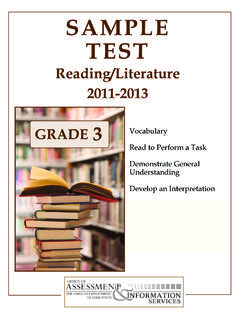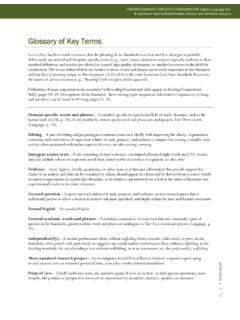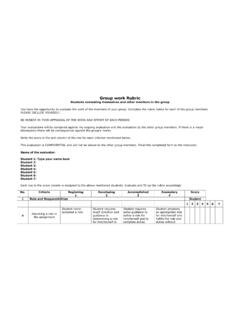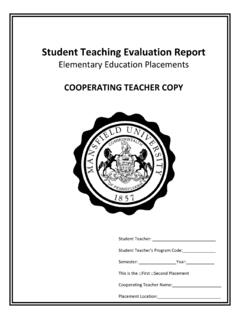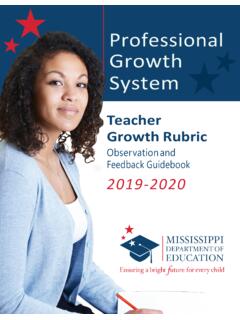Transcription of RUBRICS FROM THE FRAMEWORK FOR TEACHING …
1 RUBRICS FROMTHE FRAMEWORK FOR TEACHINGEVALUATION INSTRUMENT2013 EDITIONCHARLOTTE DANIELSONE xcerpt from The FRAMEWORK for TEACHING evaluation Instrument, 2013 Edition. Copyright 2013 The Danielson Group. All rights 1: Planning and PreparationComponentUnsatisfactoryBasiPr oficientDistinguished1a: Demonstrating Knowledge of Content and PedagogyIn planning and practice, the teacher makes content errors or does not correct errors made by students. The teacher displays little understanding of prerequisite knowledge important to student learning of the content. The teacher displays little or no understanding of the range of pedagogical approaches suitable to student learning of the teacher is familiar with the important concepts in the discipline but displays a lack of awareness of how these concepts relate to one another. The teacher indicates some awareness of prerequisite learning, although such knowledge may be inaccurate or incomplete.
2 The teacher s plans and practice reflect a limited range of pedagogical approaches to the discipline or to the students. The teacher displays solid knowledge of the important concepts in the discipline and how these relate to one another. The teacher demonstrates accurate understanding of prerequisite relationships among topics. The teacher s plans and practice reflect familiarity with a wide range of effective pedagogical approaches in the teacher displays extensive knowledge of the important concepts in the discipline and how these relate both to one another and to other disciplines. The teacher demonstrates understanding of prerequisite relationships among topics and concepts and understands the link to necessary cognitive structures that ensure student understanding. The teacher s plans and practice reflect familiarity with a wide range of effective pedagogical approaches in the discipline and the ability to anticipate student : Demonstrating Knowledge of StudentsThe teacher displays minimal understanding of how students learn and little knowledge of their varied approaches to learning, knowledge and skills, special needs, and interests and cultural heritages and does not indicate that such knowledge is teacher displays generally accurate knowledge of how students learn and of their varied approaches to learning, knowledge and skills, special needs, and interests and cultural heritages, yet may apply this knowledge not to individual students but to the class as a teacher understands the active nature of student learning and attains information about levels of development for groups of students.
3 The teacher also purposefully acquires knowledge from several sources about groups of students varied approaches to learning, knowledge and skills, special needs, and interests and cultural teacher understands the active nature of student learning and acquires information about levels of development for individual students. The teacher also systematically acquires knowledge from several sources about individual students varied approaches to learning, knowledge and skills, special needs, and interests and cultural : Setting Instructional OutcomesThe outcomes represent low expectations for students and lack of rigor, and not all of these outcomes reflect important learning in the discipline. They are stated as student activities, rather than as outcomes for learning. Outcomes reflect only one type of learning and only one discipline or strand and are suitable for only some represent moderately high expectations and rigor.
4 Some reflect important learning in the discipline and consist of a combination of outcomes and activities. Outcomes reflect several types of learning, but teacher has made no effort at coordination or integration. Outcomes, based on global assessments of student learning, are suitable for most of the students in the outcomes represent rigorous and important learning in the discipline and are clear, are written in the form of student learning, and suggest viable methods of assessment. Outcomes reflect several different types of learning and opportunities for coordination, and they are differentiated, in whatever way is needed, for different groups of outcomes represent high-level learning in the discipline. They are clear, are written in the form of student learning, and permit viable methods of assessment. Outcomes reflect several different types of learning and, where appropriate, represent both coordination and integration.
5 Outcomes are differentiated, in whatever way is needed, for individual : Demonstrating Knowledge of ResourcesThe teacher is unaware of resources to assist student learning beyond materials provided by the school or district, nor is the teacher aware of resources for expanding one s own professional skill. The teacher displays some awareness of resources beyond those provided by the school or district for classroom use and for extending one s professional skill but does not seek to expand this knowledge. The teacher displays awareness of resources beyond those provided by the school or district, including those on the Internet, for classroom use and for extending one s professional skill, and seeks out such resources. The teacher s knowledge of resources for classroom use and for extending one s professional skill is extensive, including those available through the school or district, in the community, through professional organizations and universities, and on the Internet.
6 1e: Designing Coherent InstructionLearning activities are poorly aligned with the instructional outcomes, do not follow an organized progression, are not designed to engage students in active intellectual activity, and have unrealistic time allocations. Instructional groups are not suitable to the activities and offer no of the learning activities and materials are aligned with the instructional outcomes and represent moderate cognitive challenge, but with no differentiation for different students. Instructional groups partially support the activities, with some variety. The lesson or unit has a recognizable structure; but the progression of activities is uneven, with only some reasonable time of the learning activities are aligned with the instructional outcomes and follow an organized progression suitable to groups of students. The learning activities have reasonable time allocations; they represent significant cognitive challenge, with some differentiation for different groups of students and varied use of instructional groups.
7 The sequence of learning activities follows a coherent sequence, is aligned to instructional goals, and is designed to engage students in high-level cognitive activity. These are appropriately differentiated for individual learners. Instructional groups are varied appropriately, with some opportunity for student choice. 1f: Designing Student AssessmentsAssessment procedures are not congruent with instructional outcomes and lack criteria by which student performance will be assessed. The teacher has no plan to incorporate formative assessment in the lesson or procedures are partially congruent with instructional outcomes. Assessment criteria and standards have been developed, but they are not clear. The teacher s approach to using formative assessment is rudimentary, including only some of the instructional outcomes. All the instructional outcomes may be assessed by the proposed assessment plan; assessment methodologies may have been adapted for groups of students.
8 Assessment criteria and standards are clear. The teacher has a well-developed strategy for using formative assessment and has designed particular approaches to be used. All the instructional outcomes may be assessed by the proposed assessment plan, with clear criteria for assessing student work. The plan contains evidence of student contribution to its development. Assessment methodologies have been adapted for individual students as the need has arisen. The approach to using formative assessment is well designed and includes student as well as teacher use of the assessment information. Excerpt from The FRAMEWORK for TEACHING evaluation Instrument, 2013 Edition. Copyright 2013 The Danielson Group. All rights 2: The Classroom EnvironmentComponentUnsatisfactoryBasicP roficientDistinguished2a: Creating an Environment of Respect and RapportPatterns of classroom interactions, both between teacher and students and among students, are mostly negative, inappropriate, or insensitive to students ages, cultural backgrounds, and developmental levels.
9 Student interactions are characterized by sarcasm, put-downs, or conflict. The teacher does not deal with disrespectful b of classroom interactions, both between teacher and students and among students, are generally appropriate but may reflect occasional inconsistencies, favoritism, and disregard for students ages, cultures, and developmental levels. Students rarely demonstrate disrespect for one another. The teacher attempts to respond to disrespectful behavior, with uneven results. The net result of the interactions is neutral, conveying neither warmth nor interactions are friendly and demonstrate general caring and respect. Such interactions are appropriate to the ages, cultures, and developmental levels of the students. Interactions among students are generally polite and respectful, and students exhibit respect for the teacher . The teacher responds successfully to disrespectful behavior among students.
10 The net result of the interactions is polite, respectful, and business-like, though students may be somewhat cautious about taking intellectual interactions between teacher and students and among students are highly respectful, reflecting genuine warmth, caring, and sensitivity to students as individuals. Students exhibit respect for the teacher and contribute to high levels of civility among all members of the class. The net result is an environment where all students feel valued and are comfortable taking intellectual : Establishing a Culture for LearningThe classroom culture is characterized by a lack of teacher or student commitment to learning, and/or little or no investment of student energy in the task at hand. Hard work and the precise use of language are not expected or valued. Medium to low expectations for student achievement are the norm, with high expectations for learning reserved for only one or two classroom culture is characterized by little commitment to learning by the teacher or students.


